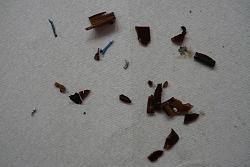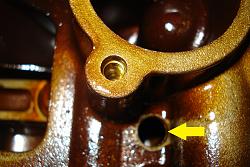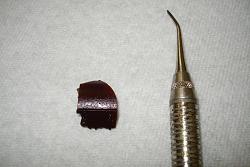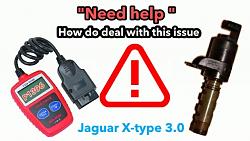Variable Valve Timing Solenoid...
#1
Hey Gang!
I recently had my 99 xk8 engine worked on by a very qualified mechanic. I had him replace a blown head gasket.
I've had it back for 3 weeks, and all of a sudden I'm getting a check engine light and a P1384 code.
Several older threads recommended trying an oil additive or doing an oil change and increasing the oil viscosity.
There's no noise coming from either of the solenoids, and the wiring checks out just fine.
My mechanic is not convinced that increasing the viscosity is the answer.
Any of you know of any good tricks or methods of diagnosing this?
The cat is past due for licensing and obviously won't pass the emissions testing with the check engine light on.
Any insights would be greatly appreciated.
I recently had my 99 xk8 engine worked on by a very qualified mechanic. I had him replace a blown head gasket.
I've had it back for 3 weeks, and all of a sudden I'm getting a check engine light and a P1384 code.
Several older threads recommended trying an oil additive or doing an oil change and increasing the oil viscosity.
There's no noise coming from either of the solenoids, and the wiring checks out just fine.
My mechanic is not convinced that increasing the viscosity is the answer.
Any of you know of any good tricks or methods of diagnosing this?
The cat is past due for licensing and obviously won't pass the emissions testing with the check engine light on.
Any insights would be greatly appreciated.
#2
Hey Gang!
I recently had my 99 xk8 engine worked on by a very qualified mechanic. I had him replace a blown head gasket.
I've had it back for 3 weeks, and all of a sudden I'm getting a check engine light and a P1384 code.
Several older threads recommended trying an oil additive or doing an oil change and increasing the oil viscosity.
There's no noise coming from either of the solenoids, and the wiring checks out just fine.
My mechanic is not convinced that increasing the viscosity is the answer.
Any of you know of any good tricks or methods of diagnosing this?
The cat is past due for licensing and obviously won't pass the emissions testing with the check engine light on.
Any insights would be greatly appreciated.
I recently had my 99 xk8 engine worked on by a very qualified mechanic. I had him replace a blown head gasket.
I've had it back for 3 weeks, and all of a sudden I'm getting a check engine light and a P1384 code.
Several older threads recommended trying an oil additive or doing an oil change and increasing the oil viscosity.
There's no noise coming from either of the solenoids, and the wiring checks out just fine.
My mechanic is not convinced that increasing the viscosity is the answer.
Any of you know of any good tricks or methods of diagnosing this?
The cat is past due for licensing and obviously won't pass the emissions testing with the check engine light on.
Any insights would be greatly appreciated.
#3
#4
This code is literally "Bank 1 VVT hold current set at a constant value of 450 ma." The faults are : oil contamination, VVT1 oil flow fault, VVT solenoid fault, VVT/Camshaft mechanical failure. The work on the head probably did this, you just have to figure out which thing is messed up. My guess is that something is restricting oil flow in the head after the R&R. Look out for an incorrect head gasket with an oil hole in the wrong place. Check for oil flow in the head bearings before going too far.
#5
With the engine idling, you can have the mechanic briefly energize the solenoids one at a time using jump leads. They will click audibly if they are electrically ok. That does NOT mean the solenoid is working perfectly. I have seen a functioning solenoid out of "time" internally, and need replacing. The engine should change characteristics; such as faltering, etc. That will tell you if things are capable of normal operation. If you find that one side responds, and the other does not, you can pull the valve covers and switch solenoids and see if the problem goes with the part to the other side. If so, replace the failed solenoid. If there is no change, you will likely be going into the front cover again. My two cents.
#6
Great information from all of you!
I'll try your suggestion about energizing each solenoid separately and see if there's any difference.
By the way, if the scanner comes up with a P1384 (or any code for that matter) two times on the same scan (Example: "3 CODES" = P1384, P1000, P1384), does that mean that both solenoids are sending error codes?
Otherwise, why two of the exact same code on a single scan?
I'll try your suggestion about energizing each solenoid separately and see if there's any difference.
By the way, if the scanner comes up with a P1384 (or any code for that matter) two times on the same scan (Example: "3 CODES" = P1384, P1000, P1384), does that mean that both solenoids are sending error codes?
Otherwise, why two of the exact same code on a single scan?
#7
The following users liked this post:
JayJagJay (11-12-2016)
Trending Topics
#8
Thanks to everyone who had replied and racked their brains on this one.
I removed the oil pan, and here's the treasure chest full of goodies that I found in it:

All remains of the broken secondary tensioner that had to be replaced 12 months ago (along with a 16th inch of sludge). Although I did expect to see some remains, I didn't expect to see quite this much.
Something came over me to prod around, so I then examined every nook and cranny inside the pan area, and examined this little hole shown by the yellow arrow:

This is the 'after' photo. When I looked inside this hole, I found another plastic 'remain' that had totally covered the hole as I prodded with a dental tool.
I positioned the plastic piece so that I could grasp the edge of it with a small needle-nose pliers, and after a good tug with the hopes of breaking it into several bite-sized removable pieces, this is what popped out in one large piece (along side my dental tool):

Here's the wildest part of all: the hole this plastic piece came out of is exactly the same diameter of the shaft of the dental tool, and there's no way that this piece of plastic could ever have come out of that hole...but it did! One of the craziest thing I have ever witnessed with my own two eyes!
I had exhausted every avenue in my pea-brain to figure this out and to keep my check engine light from popping on, and it wasn't until after I prayed about it several days ago that I felt compelled to even drop the oil pan in the first place, and I also felt compelled to do some major 'prodding' with the dental tool, which I probably wouldn't have normally done either.
I really feel that God answered my prayer on this one!
Pretty wild, EH?
I did this yesterday afternoon, and I have driven the cat about 10 times today, somewhat expecting the check engine light to come back on, but it hasn't.
Again, I want to thank you for all the work many of you put into trying to help solve this problem. JaguarForums ROCKS!
It was a real 'head-scratcher' for myself and my mechanic.
Anyway, I just wanted to give you all the good news, and that God really does answer prayers!
I removed the oil pan, and here's the treasure chest full of goodies that I found in it:

All remains of the broken secondary tensioner that had to be replaced 12 months ago (along with a 16th inch of sludge). Although I did expect to see some remains, I didn't expect to see quite this much.
Something came over me to prod around, so I then examined every nook and cranny inside the pan area, and examined this little hole shown by the yellow arrow:

This is the 'after' photo. When I looked inside this hole, I found another plastic 'remain' that had totally covered the hole as I prodded with a dental tool.
I positioned the plastic piece so that I could grasp the edge of it with a small needle-nose pliers, and after a good tug with the hopes of breaking it into several bite-sized removable pieces, this is what popped out in one large piece (along side my dental tool):

Here's the wildest part of all: the hole this plastic piece came out of is exactly the same diameter of the shaft of the dental tool, and there's no way that this piece of plastic could ever have come out of that hole...but it did! One of the craziest thing I have ever witnessed with my own two eyes!
I had exhausted every avenue in my pea-brain to figure this out and to keep my check engine light from popping on, and it wasn't until after I prayed about it several days ago that I felt compelled to even drop the oil pan in the first place, and I also felt compelled to do some major 'prodding' with the dental tool, which I probably wouldn't have normally done either.
I really feel that God answered my prayer on this one!
Pretty wild, EH?
I did this yesterday afternoon, and I have driven the cat about 10 times today, somewhat expecting the check engine light to come back on, but it hasn't.
Again, I want to thank you for all the work many of you put into trying to help solve this problem. JaguarForums ROCKS!
It was a real 'head-scratcher' for myself and my mechanic.
Anyway, I just wanted to give you all the good news, and that God really does answer prayers!
Last edited by Bowmanconsult; 05-04-2014 at 09:36 PM.
The following 4 users liked this post by Bowmanconsult:
#9
Hey I just changed out the VVT solenoid code still there p1396
I also changed out gaskets camshaft cover is there any advice for what steps should I take to try to fix the solution I have to get my car inspected - strangely it looks like the car has no effect car driving perfect there is no check engine light on dashboard but when I use the reader it shows up any advice would be great
Once again I had a issue. P1396 had it for over a month I just changed out the solenoid + gaskets no luck code still there after very expensive repair - it may be wires if so how do I inspect wires or fix - my car is already rejected I need to fix this ASAP -
I also changed out gaskets camshaft cover is there any advice for what steps should I take to try to fix the solution I have to get my car inspected - strangely it looks like the car has no effect car driving perfect there is no check engine light on dashboard but when I use the reader it shows up any advice would be great
Once again I had a issue. P1396 had it for over a month I just changed out the solenoid + gaskets no luck code still there after very expensive repair - it may be wires if so how do I inspect wires or fix - my car is already rejected I need to fix this ASAP -
#10
Hey I just changed out the VVT solenoid code still there p1396
I also changed out gaskets camshaft cover is there any advice for what steps should I take to try to fix the solution I have to get my car inspected - strangely it looks like the car has no effect car driving perfect there is no check engine light on dashboard but when I use the reader it shows up any advice would be great
Once again I had a issue. P1396 had it for over a month I just changed out the solenoid + gaskets no luck code still there after very expensive repair - it may be wires if so how do I inspect wires or fix - my car is already rejected I need to fix this ASAP -

I also changed out gaskets camshaft cover is there any advice for what steps should I take to try to fix the solution I have to get my car inspected - strangely it looks like the car has no effect car driving perfect there is no check engine light on dashboard but when I use the reader it shows up any advice would be great
Once again I had a issue. P1396 had it for over a month I just changed out the solenoid + gaskets no luck code still there after very expensive repair - it may be wires if so how do I inspect wires or fix - my car is already rejected I need to fix this ASAP -

#11
#12
#13
My mechanic explained to me that what triggers the VVT solenoid to do its thing is not the positive side as one would normally expect, but the ground wire instead through a series of grounding 'pulses' from the ECM.
Here's his actual email to me in his attempt to explain this to me:
You can look at the VVT solenoid circuit as a virtual water pipe line, when the key is in the on position the water valve to the solenoid ( B+) is always wide open and exactly the same amount of voltage that the battery is putting out at the battery posts.
The return of the water line to the ground side ( pins w/red wires) is the control valve side , where the water is restricted by rapid on and off chattering of a frequency valve ( only with the engine running ). The frequency of the on / off is the requested duty cycle.
The water used at any given time is able to be monitored by the amount used via an Amperage reading. Nothing but use will change the voltage at the B+ side and that change is never due to the inlet water valve which is always wide open.
Also make sure that you have a good strong battery installed, as if it's not putting out at least 12 volts, you could also be receiving the same code fails.
Here's his actual email to me in his attempt to explain this to me:
You can look at the VVT solenoid circuit as a virtual water pipe line, when the key is in the on position the water valve to the solenoid ( B+) is always wide open and exactly the same amount of voltage that the battery is putting out at the battery posts.
The return of the water line to the ground side ( pins w/red wires) is the control valve side , where the water is restricted by rapid on and off chattering of a frequency valve ( only with the engine running ). The frequency of the on / off is the requested duty cycle.
The water used at any given time is able to be monitored by the amount used via an Amperage reading. Nothing but use will change the voltage at the B+ side and that change is never due to the inlet water valve which is always wide open.
Also make sure that you have a good strong battery installed, as if it's not putting out at least 12 volts, you could also be receiving the same code fails.
#14
Just a heads-up for those not used to computer controlled devices: most electronically controlled devices are 'ground switched', in other words the positive side is always hot and the controlling circuit is on the ground side. The reason for this is that if the controlling circuit, which would originate in an electronic control box (read: ECU) were to short to ground it would fry the control box. If a ground switched lead shorts to ground the electronics are not damaged. If the positive side shorts to ground it just pops a fuse.
#15
Did u get to fix this issue ?
My mechanic explained to me that what triggers the VVT solenoid to do its thing is not the positive side as one would normally expect, but the ground wire instead through a series of grounding 'pulses' from the ECM.
Here's his actual email to me in his attempt to explain this to me:
You can look at the VVT solenoid circuit as a virtual water pipe line, when the key is in the on position the water valve to the solenoid ( B+) is always wide open and exactly the same amount of voltage that the battery is putting out at the battery posts.
The return of the water line to the ground side ( pins w/red wires) is the control valve side , where the water is restricted by rapid on and off chattering of a frequency valve ( only with the engine running ). The frequency of the on / off is the requested duty cycle.
The water used at any given time is able to be monitored by the amount used via an Amperage reading. Nothing but use will change the voltage at the B+ side and that change is never due to the inlet water valve which is always wide open.
Also make sure that you have a good strong battery installed, as if it's not putting out at least 12 volts, you could also be receiving the same code fails.
Here's his actual email to me in his attempt to explain this to me:
You can look at the VVT solenoid circuit as a virtual water pipe line, when the key is in the on position the water valve to the solenoid ( B+) is always wide open and exactly the same amount of voltage that the battery is putting out at the battery posts.
The return of the water line to the ground side ( pins w/red wires) is the control valve side , where the water is restricted by rapid on and off chattering of a frequency valve ( only with the engine running ). The frequency of the on / off is the requested duty cycle.
The water used at any given time is able to be monitored by the amount used via an Amperage reading. Nothing but use will change the voltage at the B+ side and that change is never due to the inlet water valve which is always wide open.
Also make sure that you have a good strong battery installed, as if it's not putting out at least 12 volts, you could also be receiving the same code fails.
#16
Would u mind knowing what fuse to check ?
Just a heads-up for those not used to computer controlled devices: most electronically controlled devices are 'ground switched', in other words the positive side is always hot and the controlling circuit is on the ground side. The reason for this is that if the controlling circuit, which would originate in an electronic control box (read: ECU) were to short to ground it would fry the control box. If a ground switched lead shorts to ground the electronics are not damaged. If the positive side shorts to ground it just pops a fuse.
Thread
Thread Starter
Forum
Replies
Last Post
Currently Active Users Viewing This Thread: 1 (0 members and 1 guests)


